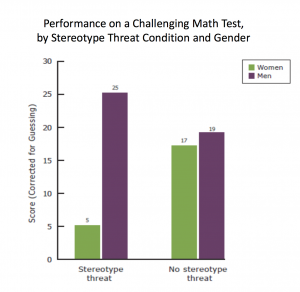Getting the Full Picture

Including all types of conflicting evidence and data into the forming of an opinion is extremely important. If you confine your reach to only studies that show one side of an argument, then you aren’t getting the full picture and what you say and believe is far less substantiated.
This was the feeling – vibe, persay – that I was receiving throughout chapter two of Why Aren’t More Women in Science? Kimura focuses her argument around studies that show slight differences in the natural abilities of men and women and attributes this to each sex’s disinterest or lack of talent in particular fields. I don’t very much appreciate how Kimura implies that the average woman is only interested in or capable of fulfilling the duties of a secretary; “There will be women who make outstanding engineers, as there are men who will make outstanding secretaries,” (Kimura 44). Women tend to excel at verbal memory and finger dexterity, while men are superior when it comes to spatial reasoning. ..and this is why men are doctors and engineers and pilots and mathematicians and women are secretaries? Because thats what women are good at? Why can’t the superior finger dexterity attributed to women make us more fit to become surgeons or electrical engineers or bomb technicians? These are all highly regarded professions that require precise finger dexterity as well.
Kimura then goes on to make points about how even when women show great interest in mathematics and score well on aptitude tests, they are far less likely than their male peers to pursue math-intensive jobs. She reasons with this by claiming the underrepresentation is actually misrepresentation, and that women don’t take these jobs because…well…they just don’t really like math.
She writes that, “there is a different distribution of not only talent but also interest in math-oriented activities across the sexes,” an opinionated claim that doesn’t account for the possibility of other factors. These women that are clearly showing skill in math, and even, “select themselves for math interest in the SMPY study,” are choosing other jobs because they don’t have an interest in math? But….didn’t they just identify themselves as being math-interested? When analyzing what is causing these mathematically inclined women t o pursue other careers you have to consider the social constructs and gender schemas present in our society. This study (Spencer, S. J., Steele, C. M., & Quinn, D. M., 1999) explains how sensitive girls are to ‘stereotype threat.’ If students were told before the test that girls weren’t expected to do well, then girls would perform substantially lower than boys. But when they’re just told to take the test, girls and boys perform much more equally.
o pursue other careers you have to consider the social constructs and gender schemas present in our society. This study (Spencer, S. J., Steele, C. M., & Quinn, D. M., 1999) explains how sensitive girls are to ‘stereotype threat.’ If students were told before the test that girls weren’t expected to do well, then girls would perform substantially lower than boys. But when they’re just told to take the test, girls and boys perform much more equally.
Studies and social experiments like this one are the key components left out of arguments such as Kimura’s. Researching all the different proposed reasons for the lower representation of women in the STEM fields is absolutely necessary to find the truth underneath it all.
Picture: Copyright SkylinePanorama